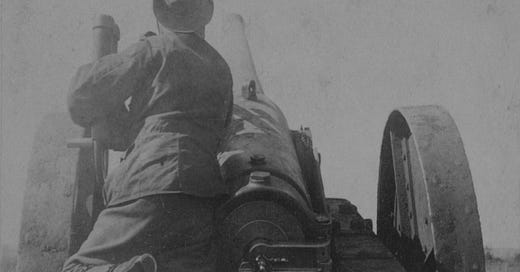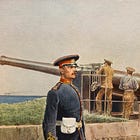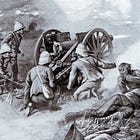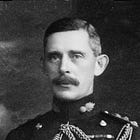The following guide will help you find previously published portions of this series.
Between the autumn of 1899 and the spring of 1900, fourteen coast defence companies - two from local ports and twelve from other parts of the British Empire - reported for duty with the force assembling for a campaign against the Boer republics. Soon after arriving in South Africa, these units acquired the weapons, vehicles, and draft animals that made possible their transformation into heavy batteries. Some of the ordnance acquired for this purpose, whether 4.7-inch guns taken from coastal installations or 5-inch guns that had been serving in land-locked fortresses, consisted of pieces of naval provenance that had previously been adapted to terrestrial employment. Others, such as long-barreled 12-pounders and 4.7-inch guns of slightly different sorts, came directly from the warships and warehouses of the Royal Navy.
The naval guns had been optimized to punch holes in the armored sides of enemy warships. To this end, they sported barrels of lengths that allowed them to use propellant charges large enough to impart a great deal of velocity to their shells, thereby allowing the latter to follow flat trajectories and reach distant targets. Thus, a projectile fired by the 12-pounder field gun of horse artillery batteries could only reach two-thirds as far as a shell of similar size shot by the 12-pounder heavy gun employed by some of the heavy batteries serving in South Africa.1
The long 12-pounders provided two important services to British forces in the field. First, they exploited the long fields of fire so often found on the veldt. Second, they provided British commanders with a means of outranging Boer field guns, the best of which could fire further than their counterparts in British field and horse artillery batteries. The 4.7-inch guns could do the same.2 Better yet, they could also respond, with a few hundred yards to spare, to the fire of the heaviest piece in the Afrikaner inventory, the 155mm ‘Long Tom’ imported from France.3
The 94-pound (43-kilo) shell fired by Boer 155mm (6.1-inch) pieces weighed more than twice as much as the 45-pound (20-kilo) projectiles of the 4.7-inch (120mm) gun. Nonetheless, the advantage in range enjoyed by the British weapon resulted in a profusion of positive pieces in the press. Thus, well before the spring of 1900, when conventional operations gave way to guerrilla warfare, the naval piece on its improvised carriage had found a special place in the heart of the British public. (Strange to say, the long 12-pounder, which armed a larger proportion of heavy batteries, received far fewer accolades than its heavier cousin.)4
The figures for range come from Darell D. Hall ‘Guns in South Africa, 1899-1902 (Parts I and II). Originally published in the issue of the Military History Journal for June 1971, these can be found on the website of the South African Military History Society. The other numbers were taken from the military Handbook for the 12-Pounder BL, 6 cwt. Gun, Mark I-IV (Horse Artillery) (London: HMSO, 1896) and the naval Handbook for the 12-Pounder QF Guns (London: HMSO, 1913). (‘Cwt’ abbreviates ‘hundredweight’, which equates to 50.8 kilograms or 112 pounds.)
Darell D. Hall ‘Guns in South Africa, 1899-1902 (Parts III and IV)’ Military History Journal (December 1971)
Manufactured by the French firm of Schneider et Cie., the Boer 155mm pieces bore a close resemblance to the 155mm de Bange heavy guns adopted by the French Army in 1877. For anecdotes illustrating the employment of these ‘Long Toms’, see George Crowe The Commission of the HMS Terrible, 1898-1902 (London: George Newnes, 1903.)
For many instances of the celebration of the 4.7-inch gun, peruse the back numbers of such periodicals as The Illustrated London News and The Army and Navy Gazette.












I consider it always a mistake to decommission any cannon, gun or armored vehicles that still has any military utility.
This article reinforces the point.
Thanks.